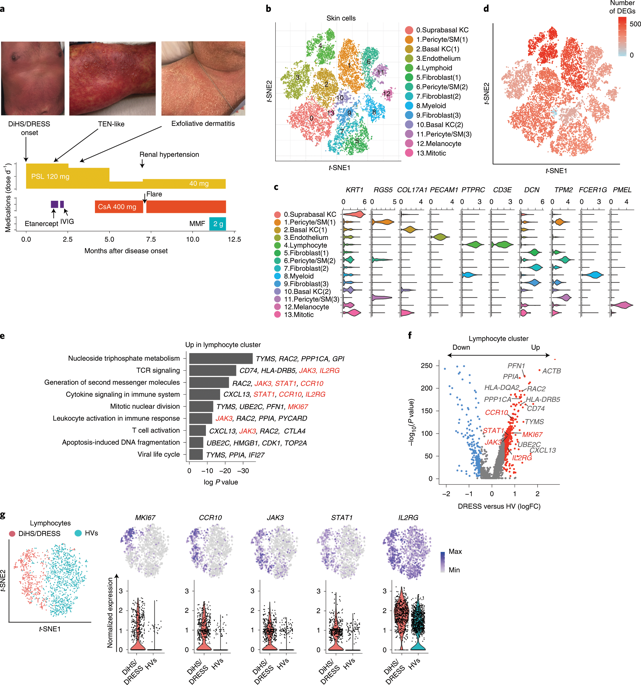Nature Medicine ( IF 58.7 ) Pub Date : 2020-01-20 , DOI: 10.1038/s41591-019-0733-7 Doyoung Kim 1, 2 , Tetsuro Kobayashi 1 , Benjamin Voisin 1 , Jay-Hyun Jo 3 , Keiko Sakamoto 1 , Seon-Pil Jin 1 , Michael Kelly 4 , Helena B Pasieka 5 , Jessica L Naff 6 , Jon H Meyerle 6 , Ijeoma D Ikpeama 7 , Gary A Fahle 7 , Fred P Davis 8 , Sergio D Rosenzweig 9 , Julie C Alejo 10 , Stefania Pittaluga 10 , Heidi H Kong 3 , Alexandra F Freeman 11 , Keisuke Nagao 1

|
Drug-induced hypersensitivity syndrome/drug reaction with eosinophilia and systemic symptoms (DiHS/DRESS) is a potentially fatal multiorgan inflammatory disease associated with herpesvirus reactivation and subsequent onset of autoimmune diseases1,2,3,4. Pathophysiology remains elusive and therapeutic options are limited. Cases refractory to corticosteroid therapy pose a clinical challenge1,5 and approximately 30% of patients with DiHS/DRESS develop complications, including infections and inflammatory and autoimmune diseases1,2,5. Progress in single-cell RNA sequencing (scRNA-seq) provides an opportunity to dissect human disease pathophysiology at unprecedented resolutions6, particularly in diseases lacking animal models, such as DiHS/DRESS. We performed scRNA-seq on skin and blood from a patient with refractory DiHS/DRESS, identifying the JAK–STAT signaling pathway as a potential target. We further showed that central memory CD4+ T cells were enriched with DNA from human herpesvirus 6b. Intervention via tofacitinib enabled disease control and tapering of other immunosuppressive agents. Tofacitinib, as well as antiviral agents, suppressed culprit-induced T cell proliferation in vitro, further supporting the roles of the JAK–STAT pathway and herpesviruses in mediating the adverse drug reaction. Thus, scRNA-seq analyses guided successful therapeutic intervention in the patient with refractory DiHS/DRESS. scRNA-seq may improve our understanding of complicated human disease pathophysiology and provide an alternative approach in personalized medicine.
中文翻译:

单细胞转录组分析指导的药物过敏综合征靶向治疗:病例报告
药物诱发的过敏综合征/药物反应伴嗜酸性粒细胞增多和全身症状 (DiHS/DRESS) 是一种潜在致命的多器官炎症性疾病,与疱疹病毒再激活和随后发生的自身免疫性疾病相关1,2,3,4 。病理生理学仍然难以捉摸,治疗选择也有限。皮质类固醇治疗难治的病例构成临床挑战1,5 ,大约 30% 的 DiHS/DRESS 患者会出现并发症,包括感染、炎症和自身免疫性疾病1,2,5 。单细胞 RNA 测序 (scRNA-seq) 的进展提供了以前所未有的分辨率剖析人类疾病病理生理学的机会6 ,特别是在缺乏动物模型的疾病中,例如 DiHS/DRESS。我们对难治性 DiHS/DRESS 患者的皮肤和血液进行了 scRNA-seq,将 JAK-STAT 信号通路确定为潜在靶点。我们进一步表明,中央记忆 CD4 + T 细胞富含人类疱疹病毒 6b 的 DNA。通过托法替尼进行干预能够控制疾病并逐渐减少其他免疫抑制剂的用量。托法替布以及抗病毒药物在体外抑制了罪魁祸首诱导的 T 细胞增殖,进一步支持了 JAK-STAT 通路和疱疹病毒在介导药物不良反应中的作用。因此,scRNA-seq 分析指导了难治性 DiHS/DRESS 患者成功的治疗干预。 scRNA-seq 可以提高我们对复杂人类疾病病理生理学的理解,并为个性化医疗提供另一种方法。











































 京公网安备 11010802027423号
京公网安备 11010802027423号